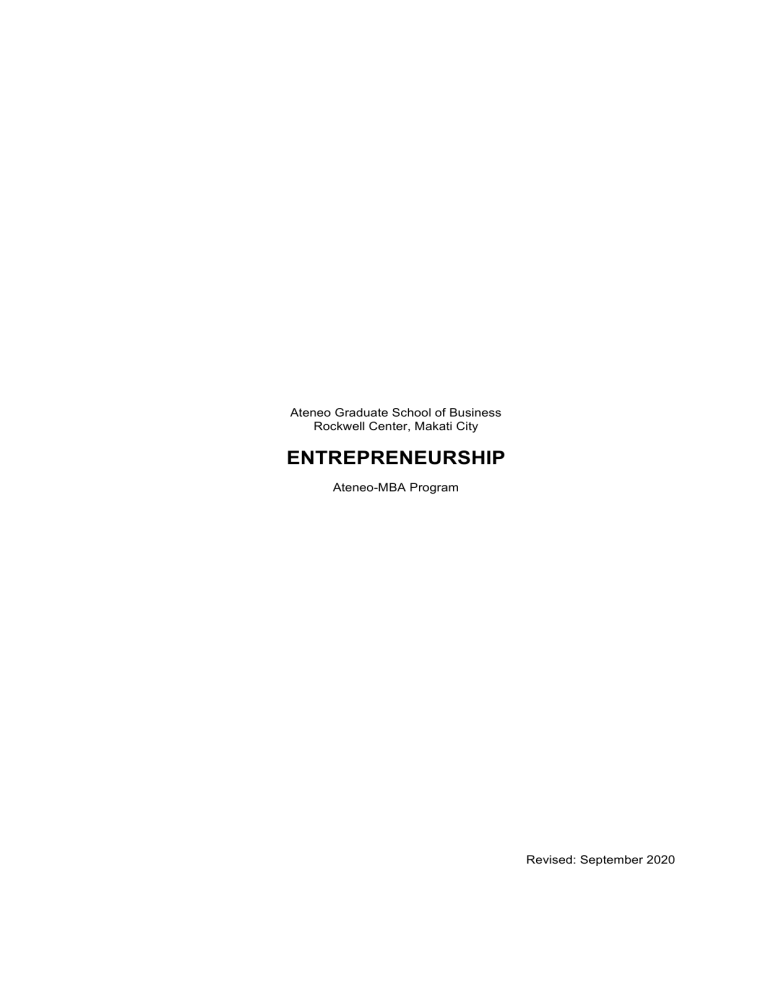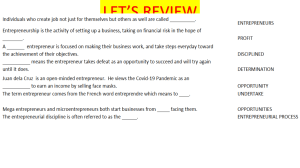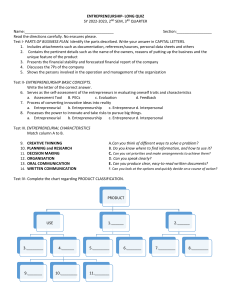
Ateneo Graduate School of Business Rockwell Center, Makati City ENTREPRENEURSHIP Ateneo-MBA Program Revised: September 2020 STRATEGIC & MARKETING MANAGEMENT DEPARTMENT Ateneo-MBA Program Ateneo Graduate School of Business Rockwell Center, Makati City COURSE TITLE: ENTREPRENEURSHIP (ONLINE COURSE) COURSE CODE: ENTREP COURSE PREREQUISITE: OPEMAN, MARKMA, FINANCE & HUMRES COURSE DESCRIPTION: Entrepreneurship is the ability to see business opportunities, to turn those opportunities into an actual business venture and to manage that venture into a growing and viable enterprise. Entrepreneurship is for those who seek an alternative to employment and are not daunted by the challenges of setting up their own businesses. This course will strive primarily to inspire and to encourage entrepreneurship, through the examination, discussion and analysis of contemporary entrepreneurs. The course provides sound principles, concepts and evaluation techniques to assess entrepreneurial capability, resource requirements and risks for increased likelihood of strategic success. COURSE OBJECTIVES: Upon successful completion of this course, learners are expected to competently: 1. Appreciate the personality profile common to entrepreneurs; 2. Identify and evaluate opportunities; 3. Learn the purposes and components of a business plan; 4. Identify the requirements and intricacies in starting a business; 5. Learn how to organize an enterprise and manage its growth; 6. Understand how to take advantage of IT and harvest opportunities; and 7. Appreciate the value of ethics, social responsibility and nation building in managing an enterprise. Entrepreneurship Online Course Ateneo MBA Program September 2020 1 COURSE OUTLINE: MODULE 0 TOPIC Introduction to Entrepreneurship Self Mastery Tests; Enterprise Creation 1 2 3 Understanding of Entrepreneurship The Anatomy of an Entrepreneur The Many Sources of Opportunities; Innovation Process Prepare list of potential Business / Serendipity Walk Opportunity Seeking and Idea Generation Discussion on Opportunities are Everywhere Ideation Techniques: SCAMPER Value Creation Blue Ocean Research Methodologies / Business Plan Framework Matching Research Strategies with Business Potential Opportunity Screening Micro Market Assessment: Customer Profiling Location, Location, Location Competitive Advantage Franchising Pathway to Entrepreneurship 4 5 6 ACTIVITIES Course Outline & Requirements; Self Introduction Brain Dominance & Personality Test Results of Self Mastery Tests Micro Market Analysis Franchising Opportunities Opportunity Seizing Entrepreneurial Life Cycle New Product Development Start-up Strategies Entrepreneurial Marketing Entrepreneurial Finance Organizational & Other Legal Issues Managing Growth Managing Entrepreneurial Operations Entrepreneurial Leadership What is Business For? Stewardship, Ethics & Social Responsibility Issues Business Plan Presentations Submission of Business Plan Paper Group discussion on the purpose of the business enterprise Pitching of Business Plan Submission of Presentation Deck COURSE REQUIREMENTS: 1. ATTENDANCE: This course consists of fifteen (15) weekly synchronous sessions of one & a half (1.5) hours each. The students are expected to attend all sessions. Absences will be governed by AGSB rules wherein only a maximum of three (3) absences are allowed. Entrepreneurship Online Course Ateneo MBA Program September 2020 2 Students are also expected to undertake do and comply with the activities identified in the asynchronous sessions. Assignments listed in the asynchronous activities should be completed and submitted prior to the synchronous sessions. 2. CANCELLATION OF CLASSES: When a session is called off for any reason, the topics and other assignments of the affected meetings are automatically rescheduled to the following session. During that following meeting, the facilitator and learners will agree on how the schedule of the remaining meetings of the course will be readjusted. 3. WORKLOAD: This course will have two sessions a week (synchronous and asynchronous sessions). The highly fast-paced nature of this course requires learners to accept a great deal of responsibility for achieving their own learning outcomes. While in class, learners are expected to actively participate in discussions and group activities. Outside of class, learners are expected to do a minimum of fifteen (15) hours per week of study, homework assignments, and/or group projects. 4. WRITTEN ASSIGNMENTS AND CLASS PRESENTATIONS An important component of this course is the completion of written assignments/reports, research output and other requirements in hard copies. Written work will be evaluated for substance and form at MBA level standards befitting an adult professional. Class presentations should meet minimum business boardroom standards. It is encouraged that these be related and applied to actual real world activities and occurrences. The following rubric will be used in assessing the quality of written assignments: Traits Effective Analysis 1 Presents an incomplete analysis of the issues identified. 2 Presents a superficial analysis of some of the issues identified; omits necessary financial calculations. 3 Presents a thorough analysis of most issues identified; includes most necessary financial calculations. Percentage of Requirements (Exercises/Problems/Cases) Completed Failed to meet 70% of the requirements. 70-79% of the requirements are completed. 80-89% of the requirements are completed. Writing Mechanics Writing is unfocused, rambling, or contains serious errors; lacks detail and relevant data and information; poorly organized. Writing lacks clarity or conciseness and contains numerous errors; gives insufficient detail and relevant data and information; lacks organization. Writing is accomplished in terms of clarity and conciseness and contains only a few errors; included sufficient details and relevant data and in- Entrepreneurship Online Course Ateneo MBA Program September 2020 4 Presents insightful and thorough analysis of all issues identified; includes all necessary financial calculations. 95-100% of the requirements are completed. Writing demonstrates a sophisticated clarity, conciseness and correctness; includes thorough details and relevant data and in3 formation; wellorganized. formation; extremely wellorganized. The following rubric will be used in assessing the quality of the presentation: Traits Content Did the presentation have valuable material relevant to the topics assigned? 1 Presentation contained little to no valuable material. 2 Presentation had moments where valuable material was present but as a whole content was lacking. 3 Presentation had a good amount of material (occasionally using exercises and problems to illustrate a concept or citing actual business cases) and benefited the class. Organization Was the presentation well organized and easy to follow? The presentation lacked organization and had little evidence of preparation. There were minimal signs of organization or preparation. Presentation Did the presenters speak clearly? Did they engage the class? Was it obvious the material had been rehearsed? Collaboration Did everyone contribute to the presentation? Did everyone seem well versed in the material? Presenters were unconfident and demonstrated little evidence of planning prior to presentation. Presenters were not consistent with the level of confidence/ preparedness they showed the classroom but had some strong moments. Presentation had organizing ideas but could have been much stronger with better preparation. Presenters were occasionally confident with their presentation however it was not as engaging as it could have been for the class. The members never worked from others’ ideas. It seems as though only a few people worked on the presentation. The members sometimes worked from others’ ideas. However it seems as though certain people did not do as much work as others. Use of Media Did the group use any media or materials to support their presentation? Did they reinforce the presentation and are appropri- Media is superfluous or nothing was used during the presentation. Relies heavily on the media used. Materials rarely support the presentation. Entrepreneurship Online Course Ateneo MBA Program September 2020 The members worked from others’ ideas most of the time. And it seems like everyone did some work, but some people are carrying the presentation. Looks at the materials often to keep track of the presentation. They are easy to use and understand. 4 Presentation had an exceptional amount of valuable material (using exercises and problems to illustrate a concept, citing actual business cases) and was beneficial to the class. Presentation was well organized, well prepared and easy to follow. Presenters were all very confident in delivery and they did an excellent job of engaging the class. Preparation is evident. The members always worked from others’ ideas. It was evident that all contributed equally to the presentation. Media are used effortlessly to enhance presentation. Materials are appropriate, easy to understand, and attractive. 4 ate, easy to understand and attractive? 5. INDIVIDUAL BUSINESS PLAN: Each learner is required to submit a business plan as a final paper and pitch their presentations in Module 6. 6. RESEARCH WORK: AGSB recommends the use of standard style guides with preference to that of the American Psychological Association (APA). The following websites are suggested as guide references: • • • http://www.aresearchguide.com/styleguides.html http://apastyle.org/electref.html http://www.bedfordstrmartins.com/online/shrttoc.html METHODOLOGY & INTEGRATION: This course is offered normally to senior students who are expected to have completed pre-requisites or majority of the core courses because of its integrative and wide-ranging features. Likewise, learners can enhance their learning process if they have good access to IT facilities such as computers, internet services and other office systems. It should be noted that this course will be conducted with the use of facilitative and interactive methods appropriate for adult learners such as cases studies, group discussions and exercises, quizzes, individual and group presentations, role playing and other learning and skill-building approaches. Such methodologies are designed to enhance the personal development of students who will take on leadership roles in their future endeavors. It is expected that the learner will have completed the assigned research/readings prior to synchronous sessions. The short lectures will, in most instances, serve to augment the readings and research material and will form the backdrop in favor of maximum discussions by the learners in an interactive and facilitative mode. In all instances, the learner is expected to contribute to class discussions. As may be applicable, the case method and/or individual/group reports shall be used. It is expected of learners to seek things out for themselves, because real education is often a process of drawing out the learners’ minds, not of pouring in ideas. The learner is expected to expand his research outside of the handouts and textbooks. GRADING SYSTEM: Reports Participation Business Plan Presentation Project Paper Total 40% 10% 50% 40% 60% 100% The following Quality Point Index (QPI) will be used in this course: Entrepreneurship Online Course Ateneo MBA Program September 2020 5 4.0 3.5 3.0 2.5 2.0 0.0 INC UW Excellent/Outstanding Superior Very Satisfactory Above Average Average Fail W 98-100 95-97 92-94 89-91 86-88 (minimum pass) Failed Incomplete Unauthorized Withdrawal (equivalent to a failing mark) Officially Withdrawn SPECIAL ACCOMMODATIONS: If a learner is in need of course adaptation or special considerations due to certain disability or other problems or constraints, the same should be discussed with the facilitator. ACADEMIC INTEGRITY POLICY: Each learner is responsible in knowing the standards that apply to academic integrity and undertakings. Academic dishonesty will not be tolerated and will result in the maximum penalty allowable as defined n the Student Guidebook. The following are considered serious violations per Guidebook: • Cheating during exams • Submitting spurious reports copied from previous materials other than his/her own. • Plagiarism. In understanding what constitutes Plagiarism, see the following sites: http://www.engl.niu.edu/comskills/students/plagiarism/Plagiarism.html http://www.monet.k12.ca.us/Challenge/Plagiarism/Plagiarism.htm In addition to what is stated in the Guidebook, the following are examples of academic dishonesty, which are pertinent to the requirements of this course: • Copying another student’s work including assignments and reports • Use of “crib” sheets or other hidden note for a quiz or an exam • Receiving assistance from anyone else with take-home quizzes MATERIALS OF INSTRUCTION: 1. Textbooks: Dr. Ed Morato TRILOGY ON ENTREPRENEURSHIP Jason Dela Rosa THE PRACTICAL ENTREPRNEUR Entrepreneurship Online Course Ateneo MBA Program September 2020 6 2. Other references: Bygrave, William D., THE PORTABLE MBA IN ENTREPRENEURSHIP, 3RD EDITION New York, John Wiley and Sons, Inc., 2007 Jerome A. Katz, Richard P. Green ENTREPRENEURIAL SMALL BUSINESS Boston, Mass: McGraw-Hill, 2007 Michael Schaper, Thierry Volery ENTREPRENEURSHIP AND SMALL BUSINESS: A PACIFIC RIM PERSPECTIVE, 2ND EDITION Milton, Qld:John Wiley Sons, 2007 Donald F. Kuratko, Richard M. Hodgetts ENTREPRENEURSHIP: THEORY, PROCESS, PRACTICE, 7TH EDITION Australia: Thomson/South-Western, 2007 Byrd, Mary Jane and Megginson, Leon C. SMALL BUSINESS MANAGEMENT: AN ENTREPRENEUR’S GUIDEBOOK, 6TH EDITION McGraw-Hill, 2009 Timmons, Jeffrey and Spinelli, Stephen NEW VENTURE CREATION: ENTREPRENEURSHIP FOR THE 21ST CENTURY, 8TH EDITION McGraw-Hill, 2009 Katz, Jerry ENTREPRENEURIAL SMALL BUSINESS, 2ND EDITION McGraw-Hill, 2009 Dr. Ed Morato TRILOGY ON ENTREPRENEURSHIP 3. Web References: The following APS online library resources are available for access: a. EBSCO b. Accessing Marketline Advantage Online (See Appendices A & B) The following internet resources can also be used: http://www.quickmba.com/entre/ http://hbswk.hbs.edu/topics/entrepreneurship.html http://www.managementhelp.org/soc_entr/soc_entr.htm#anchor 12345 Entrepreneurship Online Course Ateneo MBA Program September 2020 Contains related topics about entrepreneurship. Harvard Business School website that contains articles about Entrepreneurship. Includes basics and definitions of Social Entrepreneurship, types and reasons for it. 7 http://www.kauffman.org/ http://edcorner.stanford.edu/ http://www.entrepreneurship-indicators.net/ The online resource for building entrepreneurial economies. Entrepreneurship videos, podcasts and educational resources from Stanford University. International effort on a harmonization of entrepreneurship indicators and determinants. SESSION SCHEDULE: MODULE 0 Synchronous Asynchronous 1 Synchronous Asynchronous 2 Synchronous Asynchronous Synchronous Asynchronous 3 Synchronous Asynchronous Synchronous Asynchronous Synchronous Asynchronous 4 Synchronous Asynchronous TOPIC Introduction to Entrepreneurship Self Mastery Tests; Enterprise Creation Understanding of Entrepreneurship The Anatomy of an Entrepreneur The Many Sources of Opportunities; Innovation Process Opportunity Seeking and Idea Generation Ideation Techniques: SCAMPER Value Creation Blue Ocean Research Methodologies / Business Plan Framework Market Research Opportunity Screening Factors to consider in Micro Market Assessment Micro Market Assessment: Customer Profiling Location, Location, Location Competitive Advantage Franchising Opportunities Franchising Pathway to Entrepreneurship Case Studies of Successful Enterprises Opportunity Seizing Entrepreneurial Life Cycle Managing a Start-up Enterprise Entrepreneurship Online Course Ateneo MBA Program September 2020 ACTIVITIES Course Outline & Requirements; Self Introduction Brain Dominance & Personality Test Results of Self Mastery Tests Prepare list of potential Business / Serendipity Walk Discussion on Opportunities are Everywhere Matching Research Strategies with Business Potential Group Discussion Submission of Micro Market Analysis Group Discussion on Potential Franchising Opportunities Group Discussion on start-up companies 8 Synchronous Asynchronous Synchronous Asynchronous Synchronous Asynchronous Synchronous Asynchronous 5 Synchronous Asynchronous Synchronous Asynchronous 6 Synchronous 6 Synchronous New Product Development Start-up Strategies Branding and Marketing Strategies Entrepreneurial Marketing Financial Planning and Projection Entrepreneurial Finance Managing Growth Organizational Requirements Organizational Structure & Legal Issues Case Studies of Purpose Driven Organizations Entrepreneurial Leadership What is Business For? Case Studies on Social Enterprises Entrepreneurial Stewardship, Ethics & Social Responsibility Issues Final Consultations on Business Plan Preparations Individual Business Plan Presentations Individual Business Plan Presentations Entrepreneurship Online Course Ateneo MBA Program September 2020 Preparing Start-up Strategies Drafting of Marketing Plan Drafting of Financial Projections Proposed Organizational Structure Group Discussion on the Purpose of the Business Enterprise Submission of Business Plan Pitching Presentation 9






